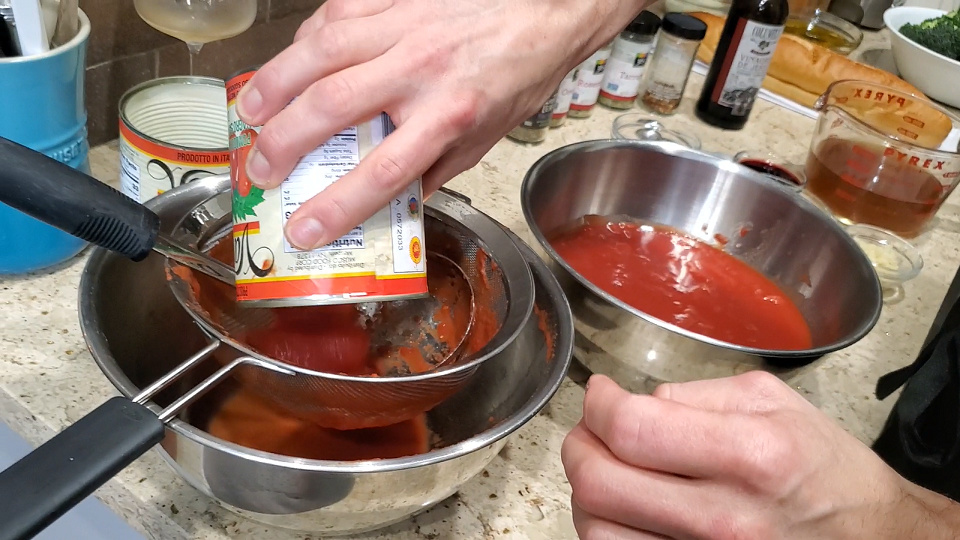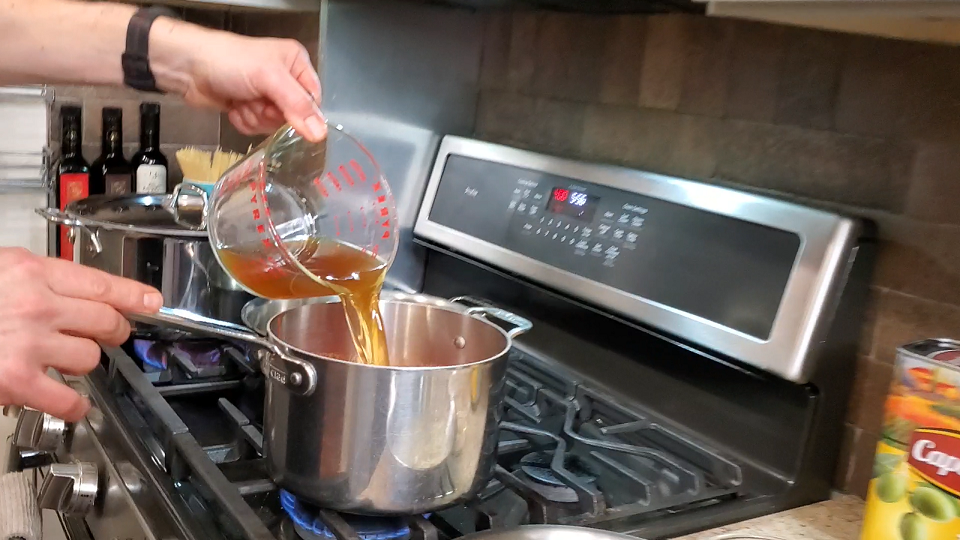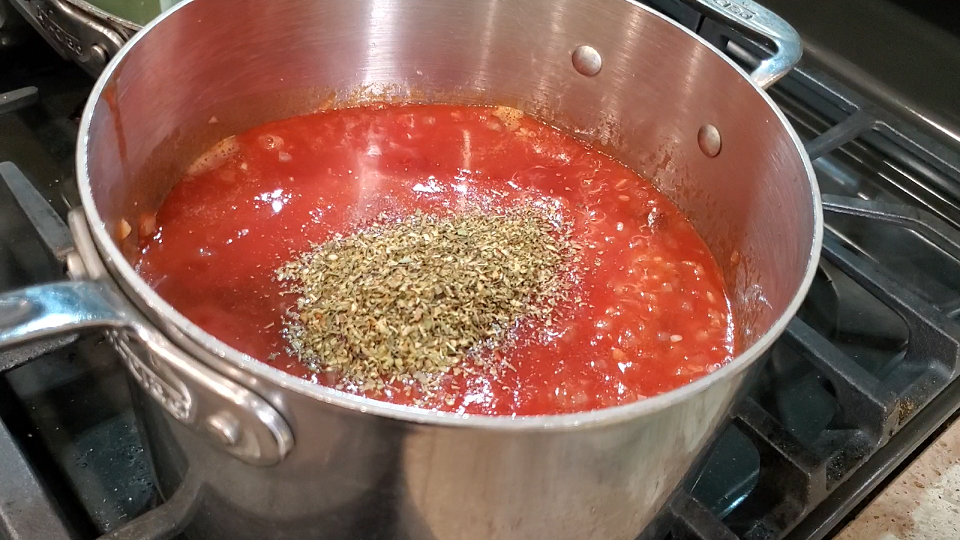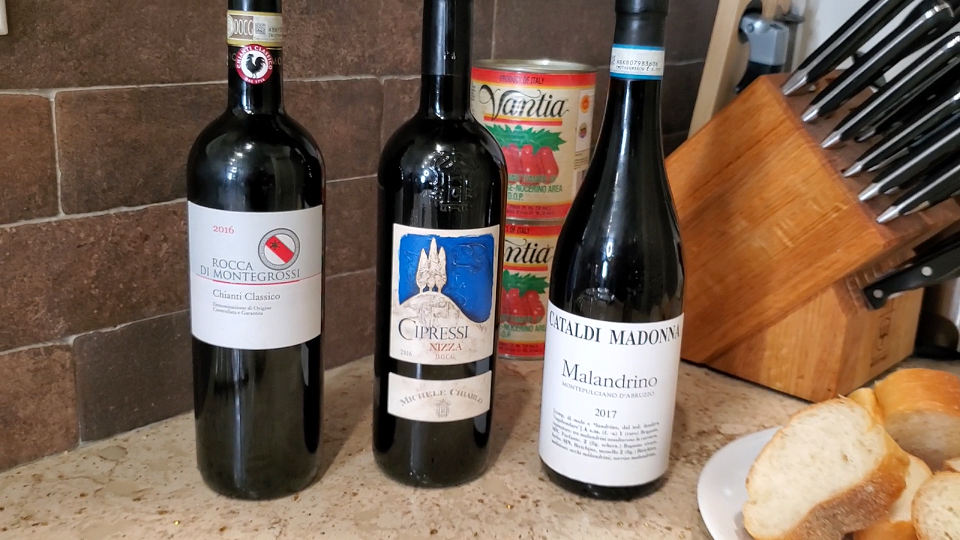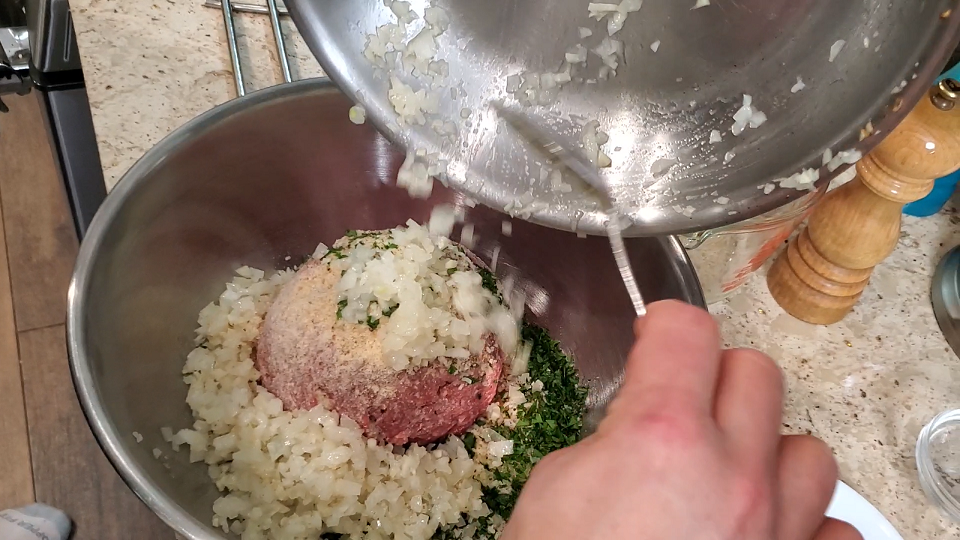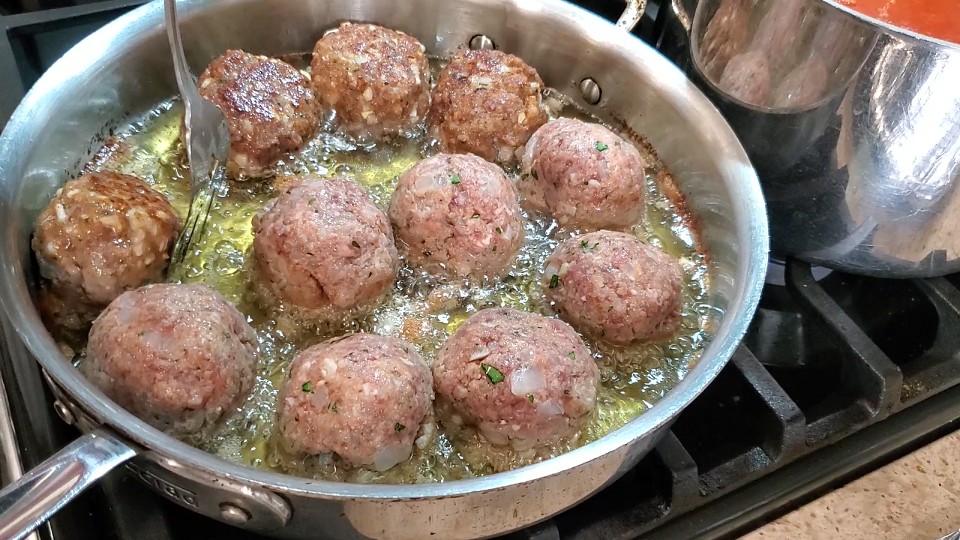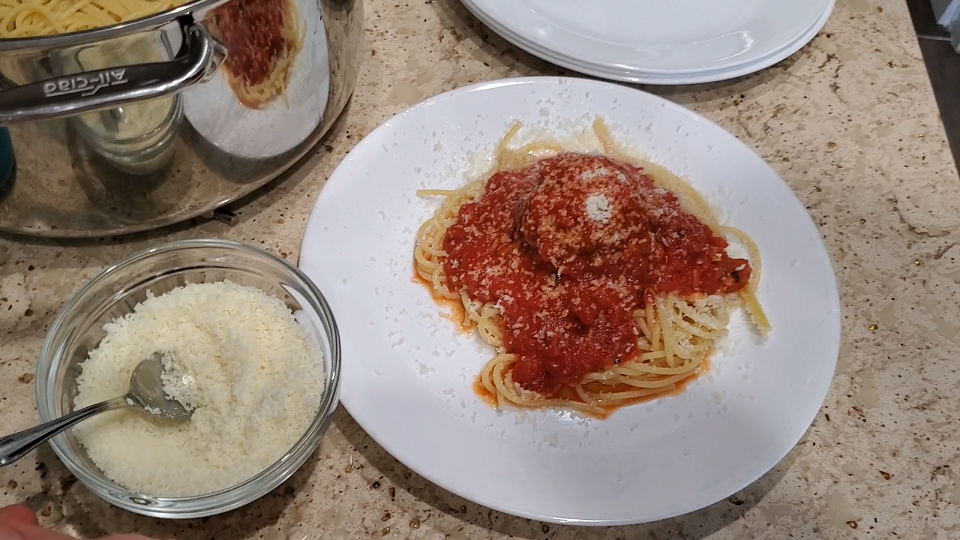Browse using the new Vinous website now. Launch →
Printed by, and for the sole use of . All rights reserved © 2015 Vinous Media
An Irish Grandma’s Italian Meatballs
And a Sunday Sauce Cheat
BY ERIC GUIDO | JUNE 12, 2020
I can still hear it now...the 1940s big band music that was always playing in my grandmother’s kitchen. Like something out of a movie, she was the patriarch of the family, having devoted every moment of every day to her family. When you were in her home, you wanted for nothing. Each end table had a small bowl of spice drops and one of chocolates; there always seemed to be tea and coffee made, not to mention a piece of cake or biscotti to accompany it. What’s more, she never sat down when the family dinner was served. Instead she would continue to usher in plate after plate of food to the dining room table, until finally my grandfather or father would holler for her to sit down before everything got cold. Through it all, the music played.
The funny part about my grandmother and her Italian cooking, which was pretty much the only kind of food that she made, is that she wasn’t even Italian. Like many Italian men in the 1920s and 1930s, my grandfather fell in love with an Irish girl, and so in order for her to be accepted into his family, she had to go to school in my great grandmother’s kitchen. You see, it wasn’t proper that their son would marry a woman that couldn’t feed him ‘properly’. That’s how it all started. Like nearly every Italian American family of the time, the food wasn’t the traditional cuisine of their region of Italy - it was Italian-American cooking. Sauce, sauce and more sauce over every kind of pasta, along with all the breaded and fried foods you could imagine. Of course there were bitter greens, calamari and seafood salads, but these large-scaled meals were all about the ziti, eggplant parm, lasagna, and of course, meatballs.
Thinking back to that kitchen, there I was as a little boy who thought that his grandmother was the most important person in his family’s world, and I was probably right. Since I wanted to spend as much time as possible with her, and I had a desire to understand cooking, I found myself in that kitchen with her up until the very moment that I was forced to sit at the table. With me underfoot, she decided that it was time that I learned to cook, and so the first recipe I was ever taught became the thing I was responsible for making each Sunday at the young age of six: my Irish grandmother’s Italian meatballs.
In the end, these meatballs would be served both dry, in a bowl, but also added to her Sunday sauce (which is an article unto itself), and so I decided to include a little Sunday Sauce Cheat, just to give you as close to the experience as I can. However, be aware that although I make these two items together in my video, to save time, I highly recommend making the sauce first, and letting it rest and slowly simmer while you finish up your meatballs.
As for the meatball recipe, to this day I still mix my meatballs by hand, and I will often adjust the ingredients by the feel of the mixture because that’s how I was taught. However, over time, an actual recipe came from it all, and that’s what I’m happy to share with you today.
The video tutorial is packed full of hints and tips to cook the perfect Italian Meatballs.
The Sunday Cheat Sauce:
You’ll notice that there’s no sugar added to this sauce. However, if you properly de-seed and remove any woody parts from your tomatoes, you won’t have to worry about balancing out any bitter flavors.
Ingredients:
2 28-ounce cans of San Marzano plum tomatoes
1 medium onion chopped fine
4 cloves garlic chopped fine
1 tsp red wine vinegar or Sherry vinegar (you can substitute ¼ cup of red wine)
1 tsp basil
1 tsp oregano
1 tsp rosemary
¼ tsp tarragon
Pinch of red pepper flakes
2 cups of beef stock
Salt and Pepper to taste
The Process:
1. Open the San Marzano tomatoes and pour into a wire mesh sieve over a large bowl. Have a second bowl off to the side. One by one, inspect each tomato, pull away any leftover skin and discard. While holding the tomato in your hand, use your thumb to break open the flesh and remove any seeds from the tomato. Don’t worry if seeds fall into the mixture in the sieve because we will be straining it all. You can also remove any woody parts from the tomato itself and discard those as well. The idea is to remove anything that may add bitterness to the sauce. Once each tomato is done, move it to your second bowl.
2. After you’ve worked through all of the tomatoes, use the bottom of a ladle to push any remaining tomato juice or paste out of the sieve. What will remain are the seeds, which can be discarded, while the juices can be combined with the plum tomatoes in the second bowl.
Pour the tomatoes into a sieve and remove the seeds and stems from the tomatoes.
3. Now, over a medium flame, pour enough olive oil into a pot or pan to just cover the bottom. Once heated through, add the onions and garlic with a pinch of salt, and allow them to sauté in the pan for three to four minutes. It’s okay if they begin to take on some color.
4. (Optional) You can add a ¼ cup of red wine to your onions and garlic at this time to accentuate the flavors of the tomatoes.
5. Add the tomato mixture, two cups of stock, red wine or Sherry vinegar, basil, oregano, rosemary, tarragon, red pepper flakes and a healthy pinch of salt to the pot, and allow this mixture to come to a simmer.
If making the sauce with meatballs, add two cups beef bone broth to the sauce.
6. Set your timer and simmer for 30 minutes, making sure to stir the sauce from time to time to prevent any items from burning on the bottom.
7. Check the sauce for seasoning and add salt and pepper as needed.
Using dried herbs in the sauce will be better for leftovers because while fresh herbs will deteriorate, the dry herbs will continue to infuse flavor over time.
8. You can serve this as is (chunky), or use an immersion blender to blend until fine.
9. If you’ve made this with meatballs, they can now be added to the sauce and allowed to rest for ten to fifteen minutes over a low flame, so the flavors will combine.
10. Serve or save. The fact is, these are even better the following day.
An Irish Grandma’s Italian Meatballs:
Ingredients: (Makes 12 medium-sized meatballs):
½ pound ground beef
½ pound ground pork
½ pound ground veal
1 medium yellow onion (small dice)
4 cloves of garlic (small dice)
2 tbls chopped Italian Parsley (rough chop)
3/4 cup fresh breadcrumbs
½ cup grated Pecorino Romano cheese
1 egg (beaten)
½ teaspoon fresh cracked pepper
1 tsp. kosher salt (plus more to season to taste)
Olive oil for sauté and frying
Suggested Wine Pairings:
Chianti Classico - Featured: 2016 Rocca di Montegrossi Chianti Classico. Find it on Delectable.
Barbera - Featured: 2016 Michele Chiarlo Barbera d'Asti Nizza Cipressi. Find it on Delectable.
Montepulciano - Featured: 2017 Cataldi Madonna Montepulciano d'Abruzzo Malandrino. Find it on Delectable.
Zinfandel. Find it on Delectable.
Share your own wine pairings on Delectable and check out what others have paired with Italian Meatballs.
The Process:
1. In a sauté pan, add enough olive oil to just cover the bottom of the pan and set the flame to medium. Allow the olive oil to heat through and add the onions with a good pinch of salt. Sweat the onions until translucent and add the garlic. Continue sweating this mixture until the garlic begins to take on color, but do not let it brown. Immediately remove the mixture from the pan to cool and spread out over parchment paper or a foil-lined sheet pan.
Once the sautéed onions and garlic have cooled, add to the remaining ingredients and mix with your hands.
2. In a large bowl, begin assembling the remaining ingredients. Add the chopped meats, egg and parsley. With clean hands (hands are the best utensil to use for this preparation), mix the contents of the bowl. Then add the onions, garlic, breadcrumbs, Pecorino Romano, pepper and salt. Mix again with your hands until fully combined. Create a small test meatball (you must taste for seasoning).
3. Fill a fry pan with enough olive oil to come half of the way up the test meatball. Put the flame on medium and allow the oil to heat through. Next, add the test meatball to the pan. Watch carefully to assure that the oil isn’t too hot. The meatball shouldn’t sear immediately but should instead stay 2-3 minutes on each side between turning. Once it has browned on each side, remove to a paper towel to drain. Let meatball cool, then taste. If it needs more salt or pepper, add it now.
Flip the meatballs every 2-3 minutes.
4. When happy with the mixture, begin to roll out your meatballs. Be careful not to make them too big, or you risk not cooking them through. You should be able to roll out about 12 meatballs.
5. Add them to the oil, again making sure they do not burn. Lower or raise the flame as necessary but remember that these will be further cooked in your sauce or the oven. Once they are browned on both sides, you have two options. First, you can continue to bake them in a 350 to 400-degree oven for five minutes and then serve them dry with sauce on the side. Or, my favorite, allow them to drain on a sheet pan or paper towel lined plate, and then add them to your sauce and simmer for another 10-15 minutes. Once done, spoon them over your favorite pasta. What’s great about this method is that the flavors of the sauce and meatballs mix and bolster each other.
Plate your Italian Meatballs and Sunday Cheat Sauce on top of your favorite pasta and serve.
In the end, the meatballs will taste great either way, and they will be even better the next day, so don’t be afraid to double this recipe and put some in the fridge for later.


